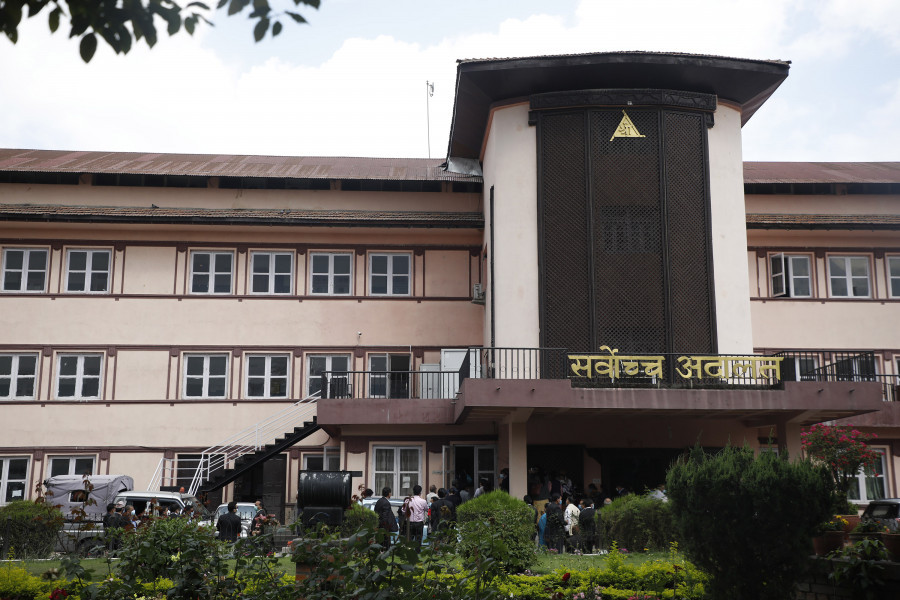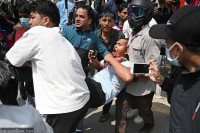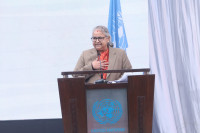National
A reconstituted bench to hear petitions against House dissolution
Chief justice to designate new justices on seniority basis to Constitutional Bench after row over his choice earlier. Two members refuse to recuse and the other two opt out.
Tika R Pradhan
Amid an unfolding political drama in Nepal, yet another drama has been witnessed in the Supreme Court, which has taken centre stage ever since Prime Minister KP Sharma Oli dissolved, for a second time in less than six months, the House of Representatives on May 21.
As questions arose over the composition of the Constitutional Bench, the Supreme Court Bar Association on Tuesday decided to intervene and held talks with Chief Justice Cholendra Shumsher Rana.
The association of lawyers practising at the Supreme Court of Nepal suggested that given the suspicions and doubts the judiciary is facing, it would be wise for Rana to reconstitute the bench by inducting justices on the basis of their seniority.
“The chief justice agreed,” said Purna Man Shakya, chair of the Supreme Court Bar Association. “The chief justice also agreed to amend the Supreme Court (Constitutional Bench Operation) Regulations 2072 BS and appoint judges to the Constitutional Bench on the basis of seniority.”
As many as 30 petitions against Oli’s House dissolution move are being examined by the Constitutional Bench, but it is yet to get into the core issues after questions were raised about its set-up.
Shakya told the Post that it could take about a week to amend the regulations as a proposal has to be presented before the full court—a bench which consists of all Supreme Court justices. “The hearing is likely to resume in about a week.”
Rana, however, called the bench on Sunday.
After Justices Bam Kumar Shrestha and Tej Bahadur Karki refused to recuse, Justices Deepak Kumar Karki and Ananda Mohan Bhattarai decided to opt out of the bench.
Rana then announced the next hearing would be conducted on June 6 after reconstituting the Constitutional Bench with justices as per their seniority.
Rana had constituted the bench with Justices Deepak Kumar Karki, Ananda Mohan Bhattarai, Tej Bahadur KC and Bam Kumar Shrestha on Friday.
Shrestha ranks 12th in terms of seniority.
Lawyers initially had questioned Shrestha’s presence on the bench not because of his seniority but because he was one of the two justices of the bench that on March 7 invalidated the Nepal Communist Party (NCP) and revived the CPN-UML and the Communist Party of Nepal (Maoist Centre). Lawyers argued that Shrestha’s presence constituted a conflict of interest, which Chief Justice Rana, however, did not agree with.
Lawyers then expressed reservations about Rana and KC’s presence as well because a bench comprising the duo on April 1 had rejected the Maoist Centre’s petition against the March 7 decision.
Nepal’s Supreme Court has come under scrutiny like never before as questions are now being raised against justices, and analysts have described the situation as the public's eroding faith in the judiciary.
Chief Justice Rana’s decision to amend the Supreme Court (Constitutional Bench Operation) Regulations to constitute a new bench has averted a possible confrontation, say experts, analysts and former justices.
“What has happened should serve as a wake-up call for the Supreme Court and its justices,” said Balaram KC, a former Supreme Court justice. “This is a good opportunity for the judiciary to regain its image. It’s incumbent upon the chief justice to start a serious conversation with senior lawyers and his colleagues and take necessary actions.”
Once the regulations are amended, the bench should consist of Chief Justice Rana, Deepak Kumar Karki, Mira Khadka, Hari Krishna Karki and Bishwambhar Prasad Shrestha.
Since Karki cannot be part of the bench for the same reason he had recused last time while hearing the December 20 House dissolution and Shrestha is in isolation, Ishwar Prasad Khatiwada and Ananda Mohan Bhattarai, who are right below them in seniority, would have to be on the bench.
During the hearing of cases against the December 20 House dissolution, questions were raised if Karki could be on the bench because he had served as attorney general in the past during Oli’s first stint as prime minister. After Karki recused himself, Sapana Pradhan Malla was roped in.
The Constitutional Bench comprising Rana, Bishowambhar Shrestha, Sapana Pradhan Malla and Tej Bahadur KC had on February 23 overturned Oli’s December 20 House dissolution.
Nepal’s constitution envisions a Constitutional Bench whenever complex constitutional issues need an explanation.
Article 137 (1) of the constitution states that there shall be a Constitutional Bench in the Supreme Court and the Constitutional Bench shall consist of the chief justice and four justices designated by the chief justice on the recommendation of the Judicial Council.
The Supreme Court (Constitutional Bench Operation) Regulations, however, do not say explicitly whether the chief justice needs to pick justices on the basis of their seniority. That gave the chief justice the leeway to pick any four justices from a roster of 14. The roster currently consists of 13 justices after Purushottam Bhandari retired last week.
Now if the amended regulations make a provision for designating justices on the basis of their seniority, the roster would lose its significance.
The composition of the Constitutional Bench had been questioned during the hearing on the December 20 House dissolution. But doubts were dispelled after the bench restored the House.
The country, however, plunged into a political crisis after the Supreme Court on March 7 in a dramatic verdict revived the UML and the Maoist Centre. People suspected if the March 7 verdict was aimed at giving a new lease of life to Prime Minister Oli who had been dealt a serious blow by the decision to overturn his House dissolution. Many also said in the March 7 verdict, the court gave more than what was demanded by the petitioner.
The petitioner, Rishi Kattel, had demanded that the court return the Nepal Communist Party to him as it was registered under his name in 2013. The court instead resurrected the UML and the Maoist Centre, which had merged in May 2018. After learning that the Nepal Communist Party was already registered in Kattel’s name, Oli and Dahal had got the Nepal Communist Party (NCP), NCP within brackets, registered under their names.
Former justices say it was the leadership of the Supreme Court that is responsible for plunging the judiciary into controversy and hence it's their responsibility to clean up the mess.
“The responsibility to keep the judiciary free of controversy is in the hands of the chief justice, as he is not an individual but an institution and his every action can have a long-term impact on the judicial process,” said Parkash Wasti, a former Supreme Court justice. “The chief justice has nothing to achieve or gain; every action of his or her must be aimed at strengthening the people’s faith in the justice process. The current chief justice does not need to do much; he just needs to make prudent moves so as not to let the judiciary lose whatever faith people have in it.”
Insiders at the Supreme Court believe that the problem arose with the decision of a five-member bench, following a writ petition, to have a roster of justices for the Constitutional Bench on March 24, 2019. Later it was expanded to 14 members by the Judicial Council after Rana took charge giving the chief justice freedom to pick justices of his liking for the Constitutional Bench.
The Supreme Court at present has a total of 20 justices.
“Today’s decision of the chief justice is appreciable because he agreed to limit his arbitrary power to select justices for the Constitutional Bench,” said one of the 20 justices of the Supreme Court who spoke on condition of anonymity. “But I don’t think the hearing could begin from Sunday as it takes more time to amend the existing regulations.”
According to the justice, the decision of the Supreme Court to set up a roster should have come into question long ago.
“That one mistake led to the controversy that we are seeing today, which has become so huge that it is threatening the very image of the judiciary,” the justice told the Post.
Anup Raj Sharma, a former chief justice, also said that the decision to form a roster was the root cause of the present controversy, which almost plunged the Supreme Court into a deep crisis.
“It’s a positive step that there has been an agreement to reconstitute the Constitutional Bench through an amendment to the regulations,” Sharma, who also headed the National Human Rights Commission, told the Post. “The chief justice’s post is such that one decision by him or her could elevate or destroy the image of the judiciary. Had the incumbent chief justice remained adamant, there could have been confrontations, the last thing we want to see in the Supreme Court.”
On Tuesday, four justices–two who refused to recuse themselves and two who decided to opt out of the bench–wrote their opinions on their decisions.
Justices Karki and Bhattarai, who decided to leave the bench, said their knowledge and the judicial ritual do not allow them to say that the debate presented in front of the bench has no connection with the 075-wo-0517 case (the March 7 decisions).
“For the independence and neutrality of this court, we felt that it would be appropriate if the justices recuse themselves from the hearing of the case (House dissolution),” states the joint opinion of Justices Karki and Bhattarai. “But it’s for them to decide.”
“The code of conduct requires a justice to refrain from the bench if any situation arises that creates suspicion over the independence of the judiciary,” the two justices wrote.
“Justice must satisfy the appearance of justice,” they added.
Tuesday’s development may have averted an imminent crisis and a possible confrontation but problems are not over yet, if the Supreme Court leadership does not introspect and make some serious revisions, according to former justices.
An amendment to the regulation alone won’t solve the problem, said Wasti, the former Supreme Court justice.
“I don’t think the regulation needs an amendmentment,” said Wasti, former justice of the Supreme Court. “Problems could arise again if the regulation is amended allowing only senior justices to the bench. What if the chief justice needs to select justices having expertise on a specific subject?”




 7.12°C Kathmandu
7.12°C Kathmandu















